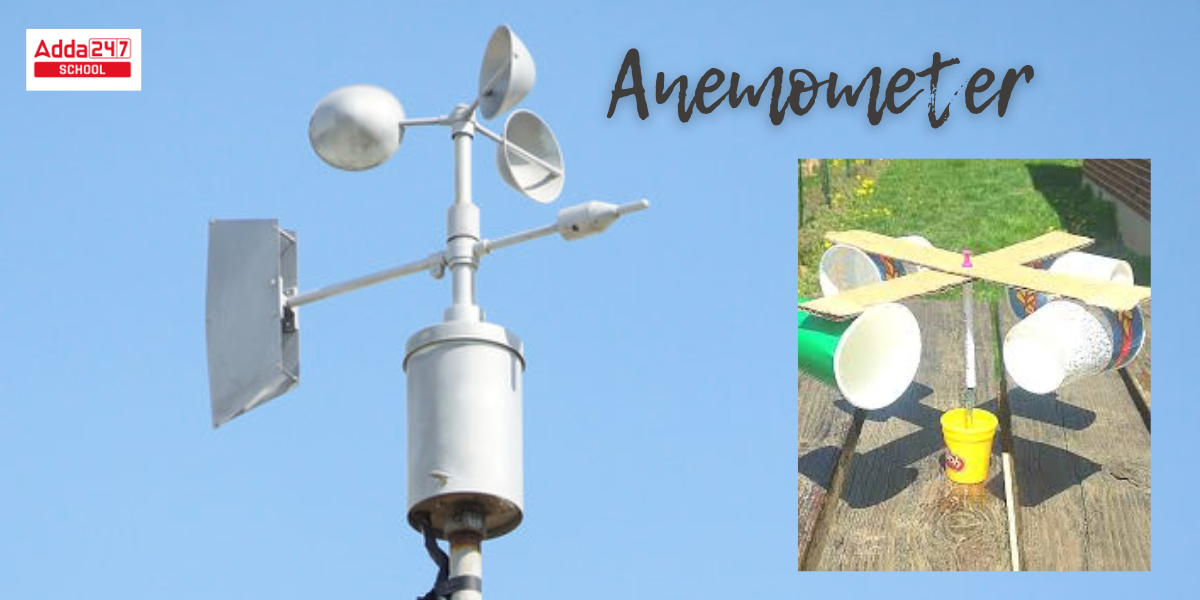Anemometer: An anemometer is an instrument used for measuring wind speed and direction. An anemometer is also a wind pressure measuring equipment. It is essential for meteorologists to analyze weather changes. Hurricanes, storms, and tornadoes may be indicated using an anemometer. Such data is critical for engineers, pilots, and climatologists to smoothly operate their works. Students need to know the working principle of an anemometer in order to understand how it determines wind speed. Students can create an anemometer model at home to study how it works and grasp the science behind it.
What is Anemometer?
An anemometer is a device that measures the speed of the wind. In 1450, Leon Battista Alberti invented the anemometer. However the instrument’s design evolved, the core concepts and essential design remained unchanged. There are numerous varieties of anemometers suitable for various conditions, scenarios, and measurements. The most common types of anemometers are:
- cup Anemometer
- Anemometers with Vanes
- Thermal Anemometers
- Hot-Wired Anemometers
- Plate Anemometers
- Laser Doppler Anemometers
- Sonic Anemometer
- Tube Anemometers
Anemometer Diagram
let’s have a look at a sample anemometer model here. This anemometer project is made by using disposable cups.

Anemometer Working Principle
A cup anemometer is also known as a Robinson anemometer. A cup anemometer is a simple measuring device, although newer, more accurate anemometers can employ lasers and ultrasonic sensing technology.
- The Cup Anemometer comprises four cups fixed at the ends of horizontal arms mounted at equal angles on a vertical shaft. It catches the wind with cup-like forms, forcing the device to spin.
- The number of times it spins in a certain time span indicates how fast the wind is blowing. The faster the cup rotates, the stronger the wind force.
- When you compute the rotation of the cup over a given time period, you get the average speed that’s utilized by researchers, meteorologists, and other professionals for a variety of applications.
How to make an Anemometer at home?
The anemometer not only measures the wind speed but also the pressure and direction of the wind. We’ll learn how to create and set up an anemometer in this anemometer -making project. The project’s goal is to construct an anemometer out of cups in order to gauge wind speed, Afterwards, we will Observe and document the changes. Although, in order to finish the anemometer science project, children must first understand how an anemometer works.
Materials
To demonstrate to children how to create an anemometer, conduct an experiment using household objects.
- Five single-use cups
- The pencil
- Glue
- two straws
- A punching machine
- A table fan
Procedure to make Anemometer
Step 1: Using a punching machine, create four holes opposite each other in a disposable cup.
Step 2: Pierce two holes in the cup with a straw, then two more holes with another straw.
Step 3: Glue four disposable cups to the arms of four straws.
Step 4: The cups should be arranged either clockwise or anticlockwise. However, ensure that all four cups are pointing in the same direction.
Step 5: Then, insert a pencil into the center of the cup located between the four cups.
Step 6: Place the cups in front of a table fan and watch the changes.
Observation
Now if you place your Anemometer in an airy space the spin of the cup was observed to increase as the wind flow increased. This allows you to count the number of revolutions made by an anemometer in a minute or an hour. Aside from that, you can see how fast the cups revolve depending on the direction of the wind.
How to caliber the Anemometer data?
Setting up your anemometer provides a foundation for comparing your obtained data. For example, if your anemometer rotates 20 times in one minute during your 10-mile-per-hour testing run, you’ll know in the future that 20 spins in one minute equals 10 miles per hour. If you would like to be even more precise, calibrate at a variety of speeds and create a chart showing your results.
How can you use your Anemometer?
If you are making an Anemometer at home for a science project, you can use it in a variety of ways later. Here are some applications for the cup anemometer.
- Take the wind speed outside your house: Place the anemometer outside in an open position where the wind is able to reach it. The wind speed is then calculated by counting while it turns.
- Measure the fan’s speed: You may measure the fan’s speed by placing the anemometer close to it. This is where the stopwatch comes into play. You may keep track of how frequently the anemometer rotates in a minute, and so on.
- On a windless day, measure the wind speed: On a windless day, you could bring your anemometer to the park and spin it for 30 seconds or so to check how many times it spins.
- You can collect data with your anemometer to compare the wind speed at different periods of the day or on different days.
- Anticipate the weather changes: You can use your anemometer to track fluctuations in wind speed, which can suggest a change in weather conditions. So you can tell when it’s going to cloud over, sunny, or pour.
Advantages of the Anemometer Project
The most enjoyable aspect of performing any scientific project at home is creating an engaging and interesting learning environment for young learners. It will undoubtedly pique their interest in creating new things. The following are some of the advantages of knowing about an anemometer project:
- Understands the operation of an anemometer.
- Gives in-depth knowledge about an anemometer and its use.
- Allows youngsters to do an experiment in an organized manner.
- Aids children in making an instrument out of items found at home.
- Allows youngsters to comprehend the significance of utilizing an anemometer in a variety of situations.
- Improves children’s scientific knowledge and helps them do better in school.
- Aids youngsters in accurately determining wind speed with an anemometer.
Anemometer Uses
Anemometers are mostly used in applications such as weather stations, ship navigation, aviation, weather buoys, and wind turbines. Other than monitoring wind speed with an anemometer, some other uses of anemometer are as follows:
- Anemometers can be used For determining wind speed and direction.
- It can be utilized by drone or RC plane users. It is to examine the weather conditions before putting their equipment to the test.
- Wind flow and wind direction are measured using this device.
- Skydivers use Anemometers to calculate the wind speed before leaping into the void.
- It is also used by long-range shooters and pilots.
- Anemometers can also be used to measure airspeed in aerodynamics.









 CBSE Admit Card 2026 for Private & R...
CBSE Admit Card 2026 for Private & R...
 AILET 2026 AIR 1: Check Full Toppers Lis...
AILET 2026 AIR 1: Check Full Toppers Lis...
 AILET Result 2026 OUT, How to Download S...
AILET Result 2026 OUT, How to Download S...














